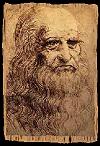|
Vasari recorded Leonardo as, "frequently occupied in the preparation of plans to remove mountains or to pierce them with tunnels from plain to plain." His studies of the Earth and work in the areas of geology led to some interesting and very advanced conclusions. He:
Val d' Arno
Leonardo's most important landscape is that of the Val d' Arno. This drawing is particularly interesting for several reasons, the main one being that it is the first of Leonardo's works which can be securely dated. On the top left-hand corner, in Leonardo's famous mirror writing, appears the notation August 5, 1473. This is accompanied with the comment that it is the feast day of the Madonna of the Snow. Calculations show us that Leonardo was 21 at the time of this drawing, which depicts a gorge and a distant valley near his birthplace of Vinci. It is an extremely detailed drawing faithfully reproducing items like the trees bending in the wind. The structure on the left is thought to be the castle of Montelupo while the valley in the distance is that of the Arno, hence the name. For this drawing Leonardo used pen and bister, along with some watercolour in more shaded areas. At the time of the sketch few landscapes were being drawn. They were considered to be lacking interest and importance, with the demand being for religious works or portraits. In doing this sketch Leonardo once more shows his individuality and it has sometimes been labelled "the first landscape drawing in Western art." On the reverse of this sheet is drawn a bridge jutting out from a group of boulders, a head wearing a crown of foliage, a study of a woman, and a nude holding a spear. There is also the notation that, "I am pleased with Anto." Rocks & Stream Rocks and Stream is an interesting drawing as it is here that the first sign of landscapes such as to be seen in Virgin of the Rocks and Mona Lisa start to put in an appearance. Whereas the cliff face shows the jutting rocks which we can recognise so well from Leonardo's later works, the ducks and pond have been described by experts as 'incompetent'. This work was the illustration for one of Leonardo's fables, "The Falcon and the Duck.": The falcon, indignant because the duck had escaped and hidden from it by diving under the surface of the water, wanted to do likewise, plunging under the water, and as its feathers got wet in this way, it was caught there, and the duck, rising in the air, mocked the drowning falcon. Storm Over an Alpine Valley This landscape was probably done during a visit by Leonardo to the Alps in 1499. Previously considered a study for the background in Mona Lisa, the links with this painting now seem to be tenuous and unlikely. The Deluge Towards the very end of his life Leonardo dropped more traditional landscapes and started producing a series of Deluge drawings. These were his last known major endeavour and show nature at her most angry, with crashing waves and swollen rivers. |
|


